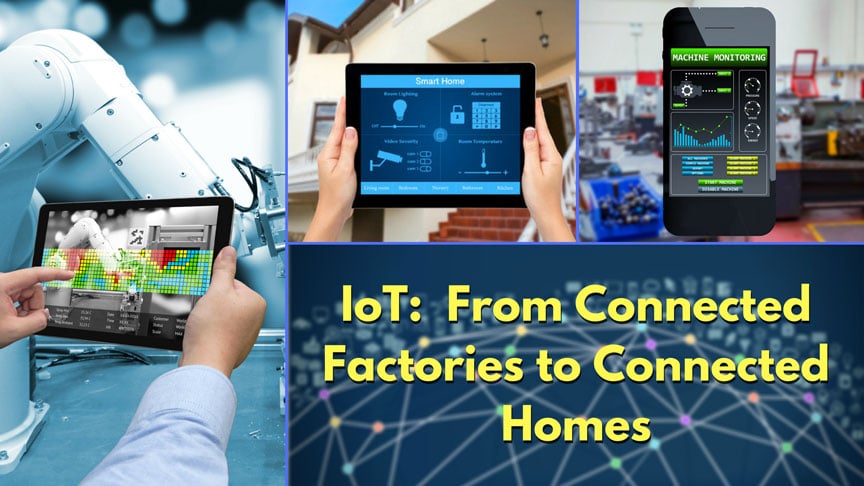This post was written by Prabhu Soundarrajan, global marketing director for Honeywell Analytics.
The Industrial Internet of Things (IIoT) has been a very popular topic. Several startup companies emerged, and major corporations introduced initiatives throughout the year. Most of us are wondering where IIoT will go within our industry. I want to offer a personal account of how I have been affected by the trend and share my thoughts on how it may impact our industry.
Having spent the past 15 years in the commercialization of innovative technology, I took it upon myself to understand the economic value created by this new technology.

Connected home
My home is now connected. Throughout the year, I piled up a number of “smart home” devices to enable my house for IoT. It started with a smart thermostat, camera, lighting, shower, security system, home theater, TV, and car. By definition everything in my home has connectivity to enable new value in comfort and flexibility. So is IoT for the connected home really new? It is really an evolution of what I am used to, with a slight premium for technology and convenience. I was happy to pay for it and enjoy the benefits of a connected home. I made the transition within a year without really noticing it. Every major retailer has IoT-enabled products and offers incentives to encourage consumers to buy IoT-enabled products.
Applications such as automatic climate control, energy management, and 24/7 security drove my willingness to pay. I paid a few hundred dollars to make my home “connected,” and my wife (boss) already appreciates it. I look like a rock star to her.
Connected industrial safety
Companies are leveraging IoT connectivity so customers can have the same level of connectivity in their workplace as I have in my home (e.g., an IoT-enabled connected safety solution for industrial workers). Industrial work environments are challenging in terms of safety hazards, compliance requirements, and exposure to risks. Unexpected events can lead to a major accident, causing downtime for several days, which in turn affects the productivity of the enterprise. Connected, safety-enabled IIoT has 24/7 real-time monitoring to provide situational awareness for the worker, supervisor, plant manager, and whoever else needs to be in the know. Gas detectors and personal protective equipment are some of the “things” in the safety space that give tremendous value when connected.
Connected workplace
The benefits already proven by connected safety solutions are tremendous. An ethanol plant in the state of Washington could detect a small leak in a storage column when a worker was doing a regular inspection. The worker transmitted information about a gas leak, which the control room operator translated as a product leak after the first few hours of system installation. This helped the plant to change work procedures and process optimization that saved more than $250,000 for the enterprise. The return on investment for a connected safety solution was only a few months.
A major petroleum refiner in Texas embraced connected safety solutions to develop a new emergency management process. It transmitted the hazard data map from gas detectors monitoring the perimeter of the facility, along with a wealth of new data, to the control room three kilometers away. An oil-processing plant in California correlated the personal exposure data for worker health and developed comprehensive work procedures for confined space entry, resulting in greater compliance with environmental regulations. This company shared best practices across its global sites securely over the cloud to enhance a culture of safety. These positive developments were not possible in the past when edge devices were not connected, but with connectivity new value streams were identified for the end user.
The practical applications of IIoT and connected safety solutions are driving three major value propositions for the enterprise:
- Safety: End users can now transition from reactive to proactive safety procedures and plan and manage the entire safety life cycle of the enterprise.
- Compliance: Work rules management has transformed from “trust” to “verification” to reduce liabilities across the enterprise.
- Productivity: Real-time, 24/7 safety data increases operational efficiency by reducing or eliminating labor-intensive procedures.
The IIoT is creating value in both home and industrial environments. The final say for the technology is in the incremental and differentiated value created for customers.
About the Author Prabhu Soundarrajan is global marketing director for Honeywell Analytics. He has served in a number of capacities as a volunteer leader, including director of ISA’s chemical and petroleum industries division (ChemPID).
Prabhu Soundarrajan is global marketing director for Honeywell Analytics. He has served in a number of capacities as a volunteer leader, including director of ISA’s chemical and petroleum industries division (ChemPID).
Connect with Prabhu:
A version of this article also was published at InTech magazine.



